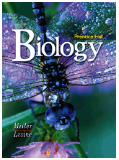|
At
the beginning of Unit 2, Joe Levine posed these questions about
the scientific future:
|
• Can
our society learn how to produce the food and energy we need while
preserving the environment?
• How will the introduction of new species affect native
plants and animals?
|
Can our society
learn how to produce the food and energy we need while preserving the
environment?
This question frames the most complex and important issues
facing humanity today. As described in Chapter 6, we face challenges
providing for human needs while protecting natural resources on both
local and global scales. Here are some links to new studies and perspectives
on various parts of this vital research frontier.
Global Warming is one of the most active areas
of current research – and for good reason. Understanding how much
our planet is warming, and why it is warming, is vital to managing just
about every aspect of human interactions with the biosphere.
The Discovery of Global Warming
http://www.aip.org/history/climate/
This hypertext history explains how scientists are learning more about
the how human activity affects earth’s climate. (On the website
of the American Institute of Physics, with additional support from the
National Science Foundation and the Alfred P. Sloan Foundation.)
Global Warming
http://earthobservatory.nasa.gov/Laboratory/PlanetEarthScience/GlobalWarming/
The Earth’s average temperature rose by more than half a degree
Celsius over the last century. What caused this change? Join NASA’s
Earth Observatory Team in an investigation into the causes and effects
of global warming. (On the website of NASA’s Earth Observatory.)
Global Warming Basics
http://www.pewclimate.org/global-warming-basics/
This section of the website of the Pew Center on Global Climate Change
attempts to educate the public and key policy makers about the causes
and potential consequences of climate change and to develop practical
and effective solutions to this environmental challenge.
EPA’s Global Warming Site
http://www.epa.gov/climatechange/
This US Government site contains lots of information on the relationship
between burning of fossil fuels, changes in global temperatures, shifts
in patterns of rainfall, and other aspects of climate change. It includes a
clikable map that lets you see what the predicted effects of global
warming might be in your region of the U. S.
Climate change and the developing world http://www.scidev.net/dossiers/index.cfm?fuseaction=dossierItem&Dossier=4&CFID=1145990&CFTOKEN=38022108
We naturally pay most attention to the effects of climate change on
the United States. We give similar priority to the impact that efforts
to slow climate change might have on our own lives. The website for
The Science and Development Network
provides a different perspective, examining the impact of climate change
on developing countries.
How will the
introduction of new species affect native plants and animals?
You might be surprised to learn how seriously exotic species
can affect places they are introduced to. Here are a few reports:
Impacts of Introduced Species in the United States
http://www.gcrio.org/CONSEQUENCES/vol2no2/article2.html
Introduced Species: The Threat to Biodiversity & What
Can Be Done By Daniel Simberloff An ActionBioscience.org original article
http://www.actionbioscience.org/biodiversity/simberloff.html
U.S. Environmental Protection Agency page on Introduced
Species in the Mid-Atlantic States
http://www.epa.gov/maia/html/intro-species.html
United States Geological Survey Regional Nonindigenous
Aquatic Species Web Sites http://nas.er.usgs.gov/links/regionallinks.html
Animated map showing Zebra Mussel Distribution An animated map showing
the spread of one of the most invasive and destructive aquatic exotic
species in the United States. http://www.nationalatlas.gov/zmussels1.html

Click
Above to Access our Index of
Science News Articles
|


